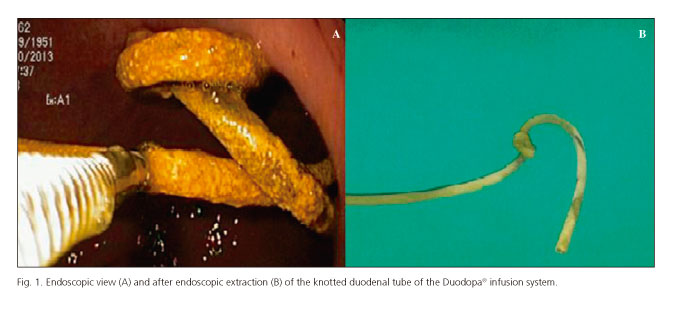My SciELO
Services on Demand
Journal
Article
Indicators
-
 Cited by SciELO
Cited by SciELO -
 Access statistics
Access statistics
Related links
-
 Cited by Google
Cited by Google -
 Similars in
SciELO
Similars in
SciELO -
 Similars in Google
Similars in Google
Share
Revista Española de Enfermedades Digestivas
Print version ISSN 1130-0108
Rev. esp. enferm. dig. vol.107 n.5 Madrid May. 2015
LETTERS TO THE EDITOR
Knotting of Duodopa® duodenal infusion system
Formación de un nudo en el sistema de infusión duodenal de Duodopa®
Key words: Duodopa. Parkinson's disease. Complications. Gastrostomy.
Palabras clave: Duodopa. Enfermedad de Parkinson. Complicaciones. Gastrostomía.
Dear Editor,
The continuous infusion of Duodopa® (levodopa + carbidopa gel) is an alternative to conventional oral therapy in patients with advanced Parkinson's disease (1), because this new treatment has shown a better control of motor fluctuations and a reduction of dyskinesias (2,3). The infusion system has a Duodopa® portable container connected to a duodenal tube placed through a gastrostomy tube.
We report on 2 patients with advanced Parkinson's disease treated with Duodopa® infusion and a knot found in the duodenal tube.
Case reports
In both patients the infusion system was placed under deep sedation using a gastrostomy kit (Freka gastric kit FR/CH15, Fresenius®). After that, an inner pigtail catheter (Freka FR/CH9, Fresenius®) was placed in the duodenal-jejunal transition under endoscopic control using a rat tooth forceps.
The first patient was a 62-year-old male who was started on Duodopa® treatment in March 2010, with improvement of dyskinesias. During a routine replacement of the Duodopa system, the inner catheter could not be removed through the gastrostomy. An upper endoscopy was performed and a knot was detected in the pigtail segment (Fig. 1A). Consequently, the inner and outer tubes were cut at the abdominal side and removed using a polypectomy snare (Fig. 1B). Then, a new gastrostomy tube was inserted using a hydrophilic guidewire inserted through the gastrostomy. Finally, a new duodenal catheter was placed through the gastrostomy tube.
The second patient was a 68-year-old female who was started on Duodopa® treatment in November 2013 because of refractory motor fluctuations. One month later she developed episodes of "on" state freezing of gate, which improved after treatment discontinuation. Following four months of therapy optimization, the device was removed under endoscopic control. During the process a knot was found in the body of the catheter, which was removed using the procedure previously described.
Discussion
The complications related to the Duodopa® continuous infusion system are mainly due to deterioration of the catheter's connection systems (3). Knotting has only been previously described in three patients (4,5). In the first one, the knot was located in the body of the duodenal tube, surrounding a gastric bezoar. In the other two cases, the knot was located in the distal zone of the catheter, correctly placed in the duodenum. In one of our patients the knot was placed in the pigtail and in the other in the body of the inner tube. Dopamine may produce antroduodenal dysmotility (6), which might favor the formation of a knot. This complication should be suspected in case of blockage of the infusion not solved with conservative management. Although it is an unusual complication, it may be advisable to remove the inner tube under endoscopic control in order to monitor any problem during its withdrawal.
Javier del-Hoyo-Francisco1, Marco Bustamante-Balén1, Irene Martínez-Torres2,
Alejandra Barrios-Barrios1, Carla Satorres-Paniagua1 and Vicente Pons-Beltrán1
1Unit of Digestive Endoscopy. Department of Digestive Medicine. Digestive Diseases Area.
2Department of Neurology. Hospital Universitari i Politècnic La Fe. Valencia, Spain
References
1. Nyholm D, Klangemo K, Johansson A. Levodopa/carbidopa intestinal gel infusion long-term therapy in advanced Parkinson's disease. Eur J Neurol 2012;19:1079-85. [ Links ]
2. Nilsson D, Nyholm D, Aquilonius SM. Duodenal levodopa infusion in Parkinson's disease-long-term experience. Acta Neurol Scand 2001; 104:343-8. [ Links ]
3. Nyholm D, Lewander T, Johansson A, et al. Enteral levodopa/carbidopa infusion in advanced Parkinson disease: Long-term exposure. Clin Neuropharmacol 2008;31:63-73. [ Links ]
4. Negreanu LM, Popescu BO, Babiuc RD, et al. Cutting the Gordian knot: The blockage of the jejunal tube, a rare complication of Duodopa infusion treatment. J Med Life 2010;3:191-2. [ Links ]
5. Krones E, Zollner G, Petritsch W. Knotting of percutaneous endoscopic jejunostomy feeding tubes in two patients with Parkinson's disease and continuous Duodopa® treatment. Z Gastroenterol 2012; 50:213-6. [ Links ]
6. Willems JL, Buylaert WA, Lefebvre RA, et al. Neuronal dopamine receptors on autonomic ganglia and sympathetic nerves and dopamine receptors in the gastrointestinal system. Pharmacol Rev 1985; 37:165-216. [ Links ]











 text in
text in 



